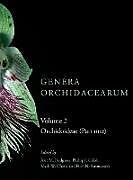Genera Orchidacearum: Volume 2. Orchidoideae (Part 1)
Einband:
Fester Einband
EAN:
9780198507109
Untertitel:
Englisch
Genre:
Biologie
Herausgeber:
Oxford Academic
Erscheinungsdatum:
18.01.2001
ISBN:
978-0-19-850710-9
... elegantly presented ... this work is undoubtedly of elevated scientific value and is able to satisfy the specialistic needs of the fascinating world of orchids.
Autorentext
Dr. Alec M. Pridgeon, Sainsbury Orchid Fellow, Royal Botanic Gardens, Kew Dr. Phillip J. Cribb, Deputy Keeper, Herbarium, and Curator, Orchid Herbarium, Royal BotanicGardens, Kew Dr. Mark W. Chase, Head, Molecular Systematics Section, Royal Botanic Gardens, Kew Dr. Finn N. Rasmussen, Associate Professor, Botanical Institute, University of Copenhagen
Klappentext
In Volume Two of Genera Orchidacearum, three of the seven tribes found in the subfamily Orchidoideae-Orchideae, Diurideae, and Diseae are thoroughly described. Each of the 101 genera in this volume receive separate treatment with sections on nomenclature and synonymy, distribution, anatomy, palynomy, embryology, cytogenetics, ecology, phytochemistry, phylogenetics, pollination, taxonomic notes, and economic uses. For those genera found in hobbyist's collections, cultivation notes emphasizing aritificial propagation are provided.
This book features distribution maps of each genus with details on the dispersion of the flowers; superb illustrations with over 120 color photographs and line drawings; cultivational details for orchid enthusiasts and growers; contributions from over 50 international orchid experts; and diagnostic illustrations that detail each genus.
Zusammenfassung
Orchids are among the most popular and widely collected of plant families, with tropical species and hybrids being cultivated the world over. This volume covers the first 100 species of the Orchidaceae family. It is useful both for scientists and for orchid breeders, and for collectors and enthusiasts.

Leider konnten wir für diesen Artikel keine Preise ermitteln ...
billigbuch.ch sucht jetzt für Sie die besten Angebote ...
Die aktuellen Verkaufspreise von 6 Onlineshops werden in Realtime abgefragt.
Sie können das gewünschte Produkt anschliessend direkt beim Anbieter Ihrer Wahl bestellen.
Loading...
Die aktuellen Verkaufspreise von 6 Onlineshops werden in Realtime abgefragt.
Sie können das gewünschte Produkt anschliessend direkt beim Anbieter Ihrer Wahl bestellen.
| # | Onlineshop | Preis CHF | Versand CHF | Total CHF | ||
|---|---|---|---|---|---|---|
| 1 | Seller | 0.00 | 0.00 | 0.00 |
